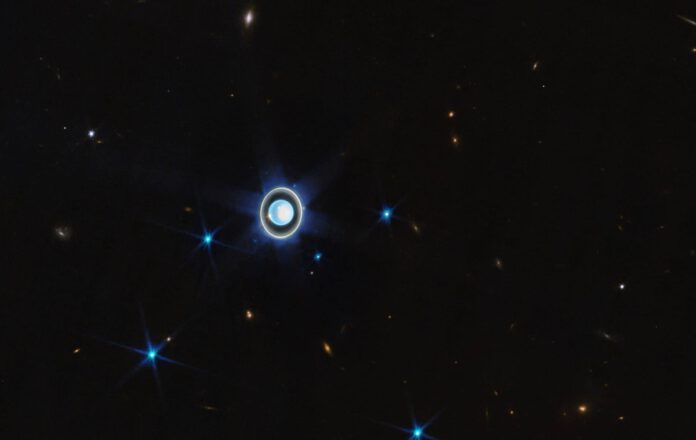
Exciting revelations stem from recent observatory efforts that have led to an increment in the counts of planetary moons. Specifically, Uranus now has an extra moon and Neptune got a double treat with two additional moons.
The Surprise Findings
The findings are indeed quite remarkable. A new moon around Uranus has been spotted for the first time in 20 years. Furthermore, one of the newly observed moons around Neptune has become known as the faintest moon yet detected by ground-based telescopes.
New Moon of Uranus
The new little moon spotted around Uranus has a diameter of just 8 kilometers. Interestingly, it’s also likely the smallest moon around the ice giant. This tiny moon takes 680 days to complete a rotation around Uranus. Currently labeled as S/2023 U1, this satellite will soon be granted its official name. While the name isn’t yet set in stone, it is assured that the moon will carry a name inspired by a character from a piece by Shakespeare or Alexander Pope, following the naming logic applied to other Uranian moons.
New Moons of Neptune
Neptune, on the other hand, welcomed two new moons. One has a diameter of approximately 23 kilometers and takes 9 years to circle Neptune, currently referred to as S/2002 N5. The second, significantly smaller, has a diameter of 14 kilometers. Known as S/2021 N1, this much fainter moon takes nearly 27 years to complete one orbital period around Neptune. Similar to Uranus’s moon, these two Neptunian satellites will also eventually acquire official names and will likely be named after sea nymphs from Greek mythology, a convention established by earlier Neptunian moons.
Observation and Discovery
Detailed observations and in-depth research paved the way for the discovery of these three moons. The two Neptunian moons, for example, were first spotted in September 2021. Follow-up observations with the Magellan telescopes in Chile in 2021, 2022, and 2023 were necessary to affirm that the brighter of the two, S/2002 N5, truly orbits Neptune. Confirming the fainter S/2021 N1 moon’s existence required additional observations from the Very Large Telescope in Chile and the Gemini Observatory in Hawaii.
Uranus’s new moon, S/2023 U1, was first noted in November of the previous year. Further observations in December enabled researchers to gauge the moon’s orbit more precisely. Armed with this information, they could identify the tiny moon in 2021 imageries from the Magellan telescopes in Chile and the Subaru telescope in Hawaii.
Orbital Elements
All three moons discovered around Neptune and Uranus orbit their primary planet at a considerable distance. Also, their orbital routes are inclined and eccentric (not perfectly circular), suggesting that they were probably captured by the ice giants’ gravitational pull shortly after these planets were born.
Similarities Among Moons
Interestingly, both Uranus and Neptune house moons with orbital elements similar to those of the newly discovered moons. For instance, S/2023 U1 shares comparable orbit traits with Uranus’s moons Caliban and Stephano, while S/2021 N1’s orbit is reminiscent of Neptune’s Psamathe and Neso. Moreover, S/2002 N4’s orbit closely resembles those of Neptunian moons Sao and Laomedeia. Such similarity is unlikely to be coincidental. It hints that these moons might have once been part of a larger celestial body that shattered, possibly due to collisions with other space bodies. The pieces then continued to orbit Uranus and Neptune in analogous paths. Thus, these sets of moons serve as testimonies to the chaos of the young solar system, where diverse objects were perpetually dynamic and colliding.
The Young Solar System
The aforementioned illuminates the significance of these three moon discoveries since they offer greater insights into the conditions of our young solar system. Researchers hope that future missions to Neptune and Uranus will yield more information about these moons and therefore more data about the early years of our solar system.
With the discovery of these new moons, Uranus’s overall moon count now stands at 28. Neptune, counting the recent findings, boasts 16 moons. Is there more to uncover? Probably! Researchers anticipate that they’ve identified all Neptune moons exceeding 14 kilometers in diameter and all Uranus moons above 8 kilometers. Smaller examples are harder to spot and unquestionably await discovery.











